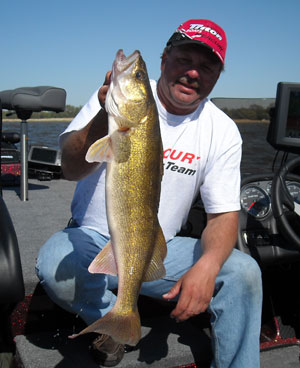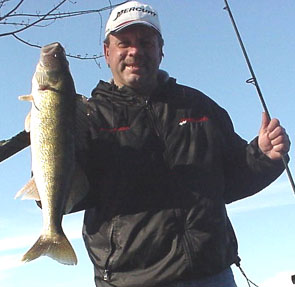Some of us never grow up.
Even in an era when fishing jargon includes terms like vertical pixels, fluorocarbon, holographic finishes and side-imaging, something as simple as a twitching bobber can still make the grumpiest old man giggle.
 Floats don’t always get their due, but they are another versatile and effective tool that will put walleyes in the boat when other presentations are impractical or unproductive. And when fished with a purpose, they can be as effective in searching for fish and covering water as pitching jigs or casting crankbaits.
Floats don’t always get their due, but they are another versatile and effective tool that will put walleyes in the boat when other presentations are impractical or unproductive. And when fished with a purpose, they can be as effective in searching for fish and covering water as pitching jigs or casting crankbaits.
In fact, the best float anglers aren’t typically kicking back while eating sandwiches and drinking coffee. They work hard to keep their boat positioned properly, their baits fishing effectively and to find the spots on the spot where hungry walleyes may be lurking.
Standard slip-bobber rigs consist of a small jig or a live bait hook (I like red hooks for the extra attraction), enough split shot so the float rides just above the surface and a thin-profile float on six- or eight-pound test, low-visability monofilament or fluorocarbon line. You can tweak your rig by adding a colored rattle bead or changing hook colors.
I prefer a float that rides low in the water for a couple of reasons. One, it isn’t as susceptible as a more exposed float to violent movement from wind gusts. Two, a walleye can usually eat the bait without detecting resistence from the float. And three, it’s easier to distinguish bites from other factors that might tip an exposed float over.
A bobber stop is secured to the line at a depth determined by the structure you are fishing and the fact that walleyes will rise to a bait but seldom descend to pick off a snack. It can be moved easily up or down the line for depth adjustments. Slip-bobbering keeps the float in-line so it can slide down to the split shot. That means the angler can reel past the bobber stop and net the fish rather than having to remove a clip-on float or hand-line a fish the final few feet to the boat.
My choice of live bait depends on the season, but in the warm-weather months like July and August, leeches and crawlers seem to produce better than minnows or chubs and they are much easier to care for when the temperature hits 90 degrees.
On a rockpile that tops out at six feet, set the bobber stop at about 5 to 5 1/2 feet to keep it out of trouble and to keep your bait working in open water instead of ducking for cover. Or, if you want to probe the boulders on the edges rather than the top, set your float accordingly. You can avoid the shallower trouble spots by the position of your boat or by limiting how far you let the float work. If you are targeting walleyes suspended in or over submerged trees and brush, target the water about a foot above that structure.
Float applications are limited only by your imagination.
However, as a general rule, it’s a presentation that works best on wind-blown structure such as points, humps, rockpiles and flooded timber.
It’s important to study the structure as much as possible before you start fishing. Today’s GPS mapping is phenomenal. My Humminbird 1197, for example, has a preloaded NVB mapping feature that not only provides accurate depth and contour information, but it shows the subtle changes in a piece of structure where walleyes tend to concentrate. Seek out cups, spines and saddles, in addition to high spots.
Approach your target area quietly and get only as close to the specific area you plan to work as you need to reach it with your floats.
If it’s a small area and winds are light or moderate, I often use my Optima-powered MinnKota Terrova bow-mount to hold my boat in an upwind position while I let my floats drift into position.
 Larger areas call for an anchor. Mine includes a six-foot length of chain at the end of a 100-foot rope to help reduce the chances of losing my anchor in rocky cover.
Larger areas call for an anchor. Mine includes a six-foot length of chain at the end of a 100-foot rope to help reduce the chances of losing my anchor in rocky cover.
Once my Triton 215 is secure, I can move around the boat to target different parts of a piece of structure. I can also enhance my chances by casting a jig or a quick-diving crankbait like a No. 5 Rattling Suspended Shad Rap while my float goes about its business.
The long anchor rope sometimes enables me to adjust my position without pulling up and moving. Start with a short rope and let out more to adjust your float’s drift. You can also alter your position slightly by moving the rope from the cleat on one side of the bow to the other. Sometimes, I set the Terrova in continuous power mode and use it to pull me over a few feet at a time and occasionally, I just fire up my 250 HP Mercury Optimax Pro XS to make a slight change in location.
For the most part, the fish we are targeting are active. If they’re in the neighborhood you’re fishing, they’re likely to bite. So, while you want to work a piece of structure over thoroughly, you can still work it quickly. If you don’t get bit, move.
If you do contact fish, take note of their location in relation to that structure. Maybe they’re on top. Maybe they’re on the deep edge. Maybe they’re set up in relation to wind direction. Maybe they’re piled up in a cup or relating to a spine of rock. Whatever is holding them on one piece of structure is likely to hold them on another, so when the bite dies off you can change locations with a game plan already in place.
I’ve employed slip floats in a few other ways, too. If I’m slowly probing a shoreline or even a weedbed with jigs or cranks, dead-sticking a float from a rod holder will keep it out of trouble and often produce some bonus fish. I’ve also worked sharp breaklines close to steep banks effectively with floats.
Hooking fish on slip bobbers can be tricky. There is no hard, fast rule. Rather, you’ll have to let the walleyes tell you how they want it. If you free-spool your rig when the float goes down, you’ll give the fish a better chance to eat it, but you also run the risk of hooking them deeper than you’d like. Try setting the hook as soon as the float goes down, and if you’re coming up empty, then start letting them run with it for a while before driving the hook home.
Slip-bobbering is a fun way to fish, and a great way to introduce young anglers to walleye fishing. It’s visual, exciting, interactive and productive.
Now you see them, now you don’t.










